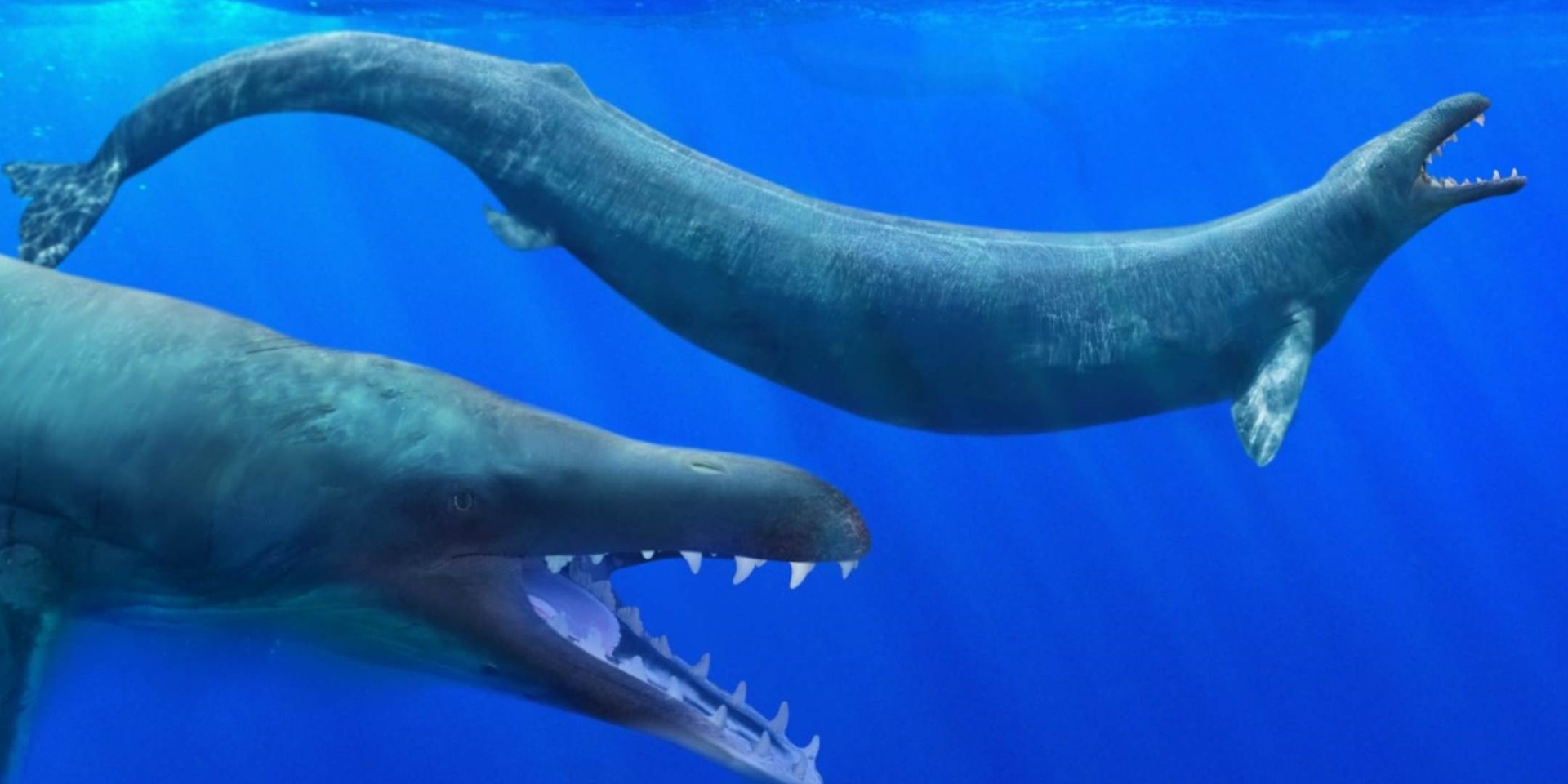
Basilosaurus, Dorudon and strange evolutionary experiments
In contrast to these amphibious protocetids, basilosaurids mark the stage when whales completely turned their back on land and became forever of the sea. This family of ancient whales, which lived from 41 to 35 million years ago, includes the oversize Basilosaurus genus. Found around the world, Basilosaurus fossils were so common in southern parts of the United States that they were used for furniture. Although known for more than a century, no complete Basilosaurus skeletons were found—until 1990, when Gingerich’s team unearthed one in Egypt and got a huge surpise. ‘I never expected that it would still have feet and toes,’ he says.
This first evidence of functioning hind limbs in fully aquatic, tail-powered swimming whales surprised Gingerich, because they would have got in the way of streamlining. ‘I thought evolution, being what it is, would have taken care of them “in a minute”,’ he says. Well-formed but very reduced in size, the hind limbs could not have supported a 6-tonne Basilosaurus, but instead may have served some purpose for mating.
An artist’s impression of two basilosaurids. When Basilosaurus was first described it was mistakenly thought to be a dinosaur, hence the ‘saurus’ in its name. ILLUSTRATION BY ROMAN UCHYTEL. REPRODUCED WITH PERMISSION
‘Basilosaurus was a very strange animal, very long and snakelike,’ says Gingerich. Though similar in girth to today’s killer whales, Basilosaurus was more than twice their length (15 to 18 metres). From the middle of the rib cage back, each vertebra is two to three times the normal length, but is relatively light and ‘spongy-looking’ inside. Since these bones most likely contained marrow in life, they probably made Basilosaurus more buoyant. The long tail ended with a small fluke. Gingerich thinks it’s possible that when under water, Basilosaurus swam with an up-and-down undulating motion, but at the surface may have made snakelike, side-to-side, S-shaped movements.
Co-existing with this huge carnivores was Dorudon, a smaller whale from the same family. In fact, scientists formerly believed Dorudon specimens were young Basilosaurus, but it’s now quite clear that relations between them were far from friendly.
In Egypt Gingerich has found a Dorudon calving ground. About half the Dorudon fossils are young animals, but they are also mixed in with many adult Basilosaurus fossils. ‘Some of the young Dorudons specimens have [Basilosaurus-inflicted] bite marks across their skulls,’ says Gingerich, ‘and we even find them as contents in Basilosaurus stomachs’.
Replica skeletons and models of three archeocetes (ancient cetaceans) show their evolution from the furry land mammal Pakicetus (right) to the amphibious Ambulocetus natans (centre) then the fully aquatic Dorudon (left). PHOTOGRAPH ANDREW FROLOWS/ANMM
Like Basilosaurus, Dorudon was a predator with big sharp teeth, and the fossilised contents of their stomachs show they ate fish. The species Dorudon atrox, for example, was about five metres long, with a fluked tail and tiny hind limbs. As in modern whales, the elbow joint in Dorudon and other basilosaurid forelimbs was not mobile, and the ‘hand’ was webbed so that individual fingers would not have been recognisable.
Fossil Dorudon skeletons are usually found curled up in a circle, often with their tails pulled right up over the skulls. This suggests their muscles would have powered the up-and-down swimming motion used by dolphins today. Dorudon’s nostril position, midway from the nose to the back of the head, would have made it easier to breathe at the water’s surface.
An artist's impression of Dorudon, which lived at the same time as Basilosaurus. Compared to Basilosaurus, Dorudon body proportions are closer to modern whales. ILLUSTRATION BY ROMAN UCHYTEL. REPRODUCED WITH PERMISSION
Was Dorudon a template for modern whales?
Were Basilosaurus and Dorudon the ancestors of today’s whales? About 36 million years ago, (a period of major ocean change—as we’ll soon see), these whales vanish from the fossil record. (They are the only group of ancient whales for which we have a record at that point in time.) Then, starting from about 34 million years ago, comes the first evidence of modern whale groups.
Though a fearsome master of the seas and the largest marine animal of its time, Basilosaurus was an evolutionary dead end. ‘We are quite certain that Basilosaurus was a specialised evolutionary experiment that isn’t what gave rise to later whales,’ says Gingerich.
The evolution of whales. Museum of New Zealand Te Papa Tongarewa
Instead, palaeontologists think Dorudon is a better model for the next stage of whale evolution (although alternative hypotheses exist). Compared to Basilosaurus, Dorudon’s proportions are closer to those of modern whales. Some see Dorudon as a general ancestral whale ‘template’ or ‘morph’ upon which evolution could have acted to generate the two main living groups of whales, Mysticeti and Odontoceti.
